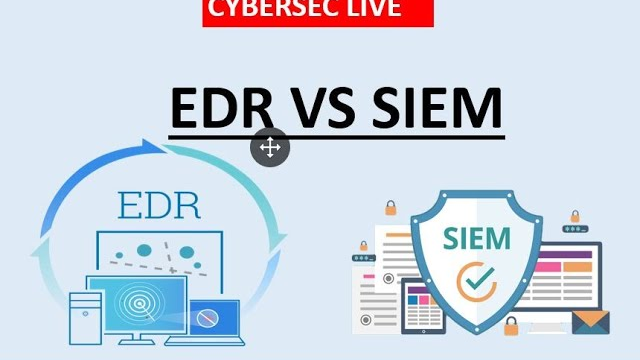EDR And SIEM EDR solutions utilize monitoring data collected from endpoint activity to detect threats that have breached network perimeters and are hiding behind legitimate processes or files.
These solutions employ advanced analytics, behavior analysis, and machine learning algorithms to detect unknown threats that bypass traditional antivirus and firewall protections. Furthermore, they equip security teams with forensic tools to analyze and respond to incidents quickly.

Threat Detection
Integral components of any security stack, EDR solutions monitor endpoints in real-time for suspicious activities that might signal an attack and collect telemetry to quickly identify attackers and provide context that speeds investigation and response efforts. For optimal protection, they should incorporate antivirus (AV) software and other endpoint protection tools for more comprehensive protection.
An effective EDR solution should utilize indicators of compromise (IOCs) to detect attacks such as ransomware, malware, and other threats, then use machine learning techniques to detect patterns that indicate suspicious activity and alert when suspicious files or activities are identified. It should also be able to quarantine malicious files while blocking persistent mechanisms and wiping and reimagining affected computers to stop the infection from spreading further.
Threat detection capabilities are essential to decrease network dwell time, thus mitigating damage and disrupting business operations while freeing up security teams for more productive hunts and responses.
A superior EDR solution uses advanced analytics and threat intelligence to correlate endpoint, network, and third-party system data to gain insight into how bad actors use various tactics and techniques to gain unauthorized access to digital assets. This gives greater clarity as to their tactics and techniques for breaking into these assets.
Incident Response
Security Information and Event Management (SIEM) technology consolidates log data from endpoints, network devices, servers, and other sources. It analyzes it in real-time or retrospectively to qualify alerts, detect threats, and manage incidents effectively. SIEM allows businesses to recognize disruptions early on and anticipate disruptions more effectively.
EDR solutions’ response capabilities enable rapid responses to detected attacks by quickly isolating compromised systems from the network, blocking malicious processes, and eliminating infection traces. They also facilitate post-incident activities, such as reviewing all aspects of an incident while learning lessons for improving future security systems.
With cyber-attacks becoming more sophisticated and aggressive, organizations of all sizes must be prepared to detect and respond swiftly. EDR tools combine various capabilities, such as pre-configured rules that detect specific threats and automatically trigger responses, analytics, forensics features that quickly identify incidents, and rapid incident investigation features. Some tools include real-time telemetry for continuous monitoring and detection of endpoint and network activity. In contrast, others rely on manual analysis by security teams combined with machine-learning algorithms to detect suspicious behaviors. They may even record activity over time so security teams can conduct forensic investigations on suspected threats that were missed by traditional protection technologies.
Analysis
Endpoint detection and response (EDR) solutions work proactively to detect threats in your environment, record and analyze data to detect suspicious behavior on your computer system and alert the appropriate teams immediately to halt attacks.
EDR solutions leverage advanced technology such as machine learning to set baseline endpoint operations and user behaviors before looking for any deviations to alert teams when threats have been identified. This gives more visibility into your organization’s security posture, helping teams identify risks more easily while meeting compliance requirements more effectively.
EDR solutions utilize continuous file analysis for increased threat detection. This technique analyzes each file that touches an endpoint and can flag any that exhibit threatening behavior – an invaluable capability when dealing with complex malware that quickly escalates after entering an organization’s network.
EDR solutions can integrate with both SIEMs and firewalls to enable centralized event management, log collection, security intelligence analysis, monitoring alerting reporting capabilities – significantly reducing alert volume for SOC security teams while making high-priority attacks easier to address quickly – something precious when dealing with modern zero-day attacks.
Reporting
EDR helps security teams quickly observe what’s happening on an endpoint in real-time and react immediately to contain or remediate threats, helping minimize attack impact and restore systems that have been affected. EDR records user activities, network connections, and file changes so security analysts can understand which threats pose the most significant dangers.
EDR tools may focus on protecting individual endpoints, but they can be combined with other security solutions to cover various threats across your network. A Security Information Event Management (SIEM) solution centralizes and analyzes alerts from various security tools – including your EDR tool – while offering visibility across the corporate network.
EDR tools are designed to safeguard endpoints, while SIEM tools monitor activity across a corporate network. SIEM can also be enhanced with additional capabilities, including forensics and threat hunting. Combined with EDR solutions, these platforms provide one centralized platform for triage, validation, and response by SOC analysts. Furthermore, EDR solutions may assist security teams in pinpointing threats by collecting system logs and memory dumps from compromised endpoints for advanced forensic analysis, helping detect threats that bypass traditional protection such as antivirus or firewall tools.
